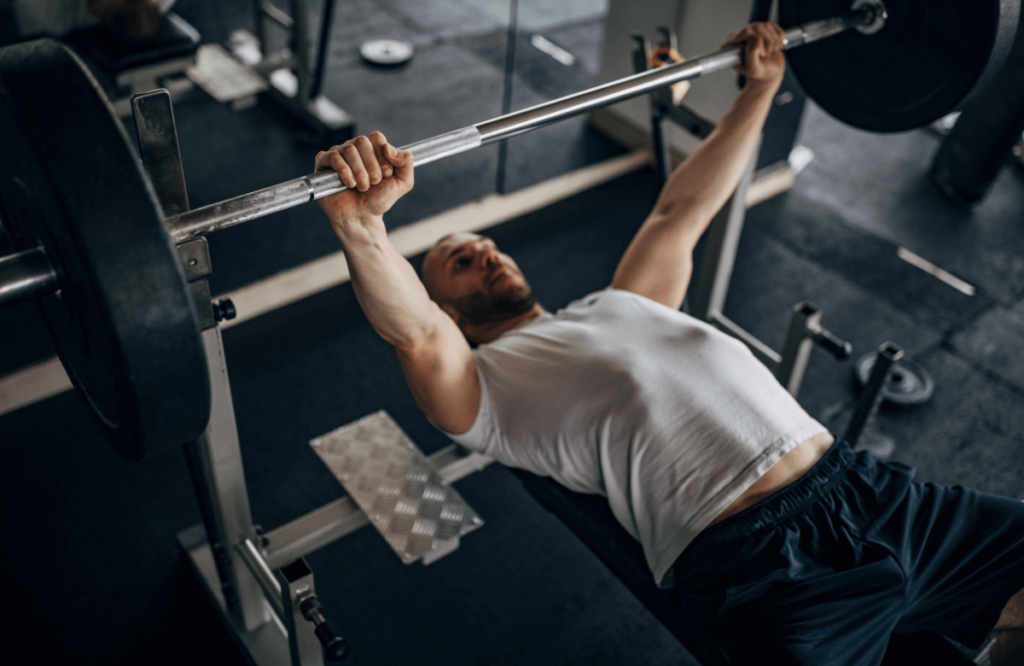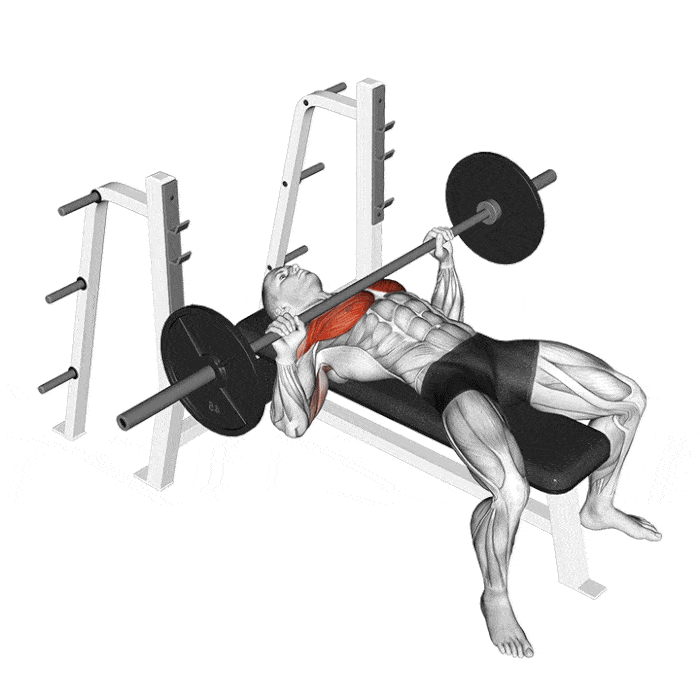The barbell bench press is one of the most popular and effective strength-training exercises in the world. Whether you’re a complete beginner to fitness or a seasoned gym-goer, the bench press is a fundamental movement that can help you build upper body strength and muscle mass. In this article, we will explore the benefits of the bench press, the muscles it targets, proper form and technique, variations, tips for beginners, and more.
Jump to:
What Is A Bench Press?
A bench press is a classic and fundamental strength-training exercise performed with a barbell or dumbbells. It involves lying flat on a flat bench while holding the barbell with hands slightly wider than shoulder-width apart. The exercise primarily targets the chest, shoulders, and triceps as the lifter lowers the bar to their chest and then pushes it back up to the starting position.
The bench press is popular among individuals of all fitness levels, from beginners to advanced lifters, due to its effectiveness in building upper body strength and muscle mass. It is a compound movement that offers numerous benefits, including improved functional strength, muscle development, and increased bone density. Proper form and technique are essential to perform the bench press safely and efficiently.
Muscles Worked By A Bench Press
The bench press primarily targets the following muscles:
Pectoralis Major: This is the large chest muscle responsible for horizontal adduction of the arm.
Anterior Deltoids: The front shoulder muscles assist in lifting and lowering the barbell.
Triceps Brachii: The muscles at the back of the upper arm play a significant role in extending the elbow during the pressing motion.
Additionally, the bench press also engages other stabilizing muscles such as the trapezius, rhomboids, and biceps to provide support during the movement.
Benefits of a Bench Press
This bench press exercise has a wide variety of benefits including intense chest development and can increase bench press strength. However, let’s go more in-depth on these bench-pressing benefits:
Upper Body Strength
The primary benefit of the bench press is that it targets several major muscle groups in the upper body. This includes the chest, shoulders, and triceps, making it an excellent exercise for overall upper body strength development.
Muscle Mass
By engaging multiple muscle groups simultaneously, the bench press is an effective compound exercise for building muscle mass. It is especially popular among bodybuilders and strength athletes.
Functional Strength
The bench press mimics pushing movements commonly encountered in daily activities and sports, enhancing functional strength and making everyday tasks easier for things like your shoulder joints and pectoral muscles. This can assist your entire body, but mostly increase shoulder mobility and core stability.
Bone Health
Weight-bearing exercises like the bench press contribute to bone density and help prevent conditions like osteoporosis.
Metabolic Boost
As a compound movement, the bench press stimulates a higher metabolic response, leading to increased calorie burn and potential fat loss.

How to Do a Bench Press
Follow these steps to perform the bench press exercise with proper form:
The Set Up
Lie on a flat bench with your eyes directly under the barbell and position your head, upper back, and glutes firmly on the weight bench. Plant your feet flat and firmly on the ground, shoulder-width apart, with your knees at a 90-degree angle. Arch your back slightly by squeezing your shoulder blades together, but avoid excessive arching.
Grip the Bar
Reach up and grip the bar with your hands slightly wider than shoulder-width apart. Your palms should face away from you in an overhand grip and make sure your grip is even on both sides of the bar.
Unrack the Bar
Take a deep breath, brace your core, and engage your chest and triceps as you lift the barbell off the rack by straightening your arms. Hold the barbell directly above your shoulders with your arms extended.

Lower the Bar
Inhale as you slowly lower the barbell towards your chest. Keep your elbows at around a 45-degree angle to your body and then lower the bar until it touches your chest lightly or reaches the lower part of your sternum.
Press the Bar
Exhale and push the barbell back up to the starting position. Fully extend your arms, but avoid locking out your elbows at the top. Then repeat these steps until your desired reps are complete.
Tips for Proper Form
Keep your shoulders back and down: Avoid shrugging your shoulders during the traditional bench lift. This helps stabilize your upper body and keep a consistent vertical bar path.
Maintain a stable base: Plant your feet firmly on the ground and keep your glutes and upper back in contact with the bench.
Avoid excessive arching: A slight arch in your lower back is okay, but don’t hyperextend, as it can lead to injuries.
Use a spotter: Especially if you’re lifting heavy weights, having a spotter can provide safety and assistance if needed.
Control the bar: Lower and lift the barbell under control and avoid dropping or bouncing the bar off your chest. This could mean not using heavier weights and excessively heavier loads or adjusting for a narrow grip or wide grip.
Breathing: Inhale as you lower the bar and exhale as you press it up. Proper breathing helps stabilize your core during the lift, especially when you start reaching your max weight.
Start with lighter weights: If you’re new to bench pressing, begin with a weight you can comfortably handle to practice proper form before increasing the load.
Practice proper grip: Ensure your grip on the bar is even and comfortable to avoid wrist strain.
Remember, the standard bench press is a compound exercise, and it’s essential to perform it correctly to reap the full benefits and minimize the risk of injury. If you’re unsure about your technique, consider seeking guidance from a qualified fitness trainer or an experienced lifter.

Bench Press Variations
If you’re looking for other upper chest training options, check out these variations of bench presses:
Dumbbell Bench Press: Instead of a barbell, use dumbbells for a more individualized range of motion.
Incline or Decline Bench Press: Perform the bench press on an incline bench (or decline bench) to target the upper body and shoulders more intensely.
Close-Grip Bench Press: Bring your hands closer together to emphasize the triceps muscles.
Smith Machine Bench Press: Utilize a Smith machine for added stability, which can be beneficial for beginners.
Floor Press: Lie on the floor and press the barbell, limiting the range of motion and focusing on strength development.
Common Mistakes
Bench pressing is a highly effective exercise, but it’s crucial to be aware of common mistakes that people often make to ensure safety and get maximum strength. Here are some of the most common mistakes done during attempting this exercise:
Lack of Proper Warm-Up
Skipping or inadequate warm-up can increase the risk of injury. Always warm up your chest, shoulders, and triceps with light exercises or dynamic stretches before starting the bench press.
Incorrect Grip Width
Gripping the barbell too wide or too narrow can affect your stability and put excessive strain on your shoulders. Aim for a slightly wider grip than shoulder-width apart–this seems to work best for most intermediate lifters.
Uncontrolled Descent
Letting the barbell drop too quickly toward your chest can lead to serious injury risk, particularly to the shoulders or chest. Lower the barbell under control, taking around 2-3 seconds to reach your chest, avoid using a heavy barbell, and check to make sure you don’t have a narrower grip than recommended.
Bouncing the Bar off the Chest
Bouncing the bar or pair of dumbbells off your chest to gain momentum for the next rep is not only dangerous but also reduces the effectiveness of the exercise. Each repetition should start from a dead stop on your chest.
Arching Back Excessively
While a slight arch in the lower back is acceptable, overarching can strain the lower back and decrease stability. Maintain a natural arch and engage your core muscles throughout the movement during dumbbell or barbell bench pressing.
Elbows Flaring Out
Allowing your elbow joints to flare out at a 90-degree angle from your body puts unnecessary stress on the shoulders during this chest exercise. Keep your elbows at around a 45-degree angle to your body to help avoid shoulder injuries.
Using Excessive Weight
Lifting too much weight beyond your capacity compromises your form and increases the risk of injury and hinders your fitness goals. Start with a weight you can handle comfortably with proper form and gradually progress.
Neglecting Scapular Retraction
Failing to retract your shoulder blades (squeeze them together) during the lift can lead to poor stability and limit muscle activation. Engage your scapulae for a stable foundation and keep your head neutral for the best results.
Not Using a Spotter
Bench pressing heavy weights without a spotter can be risky. Having a spotter provides safety so make sure you schedule your training program with that in mind.














